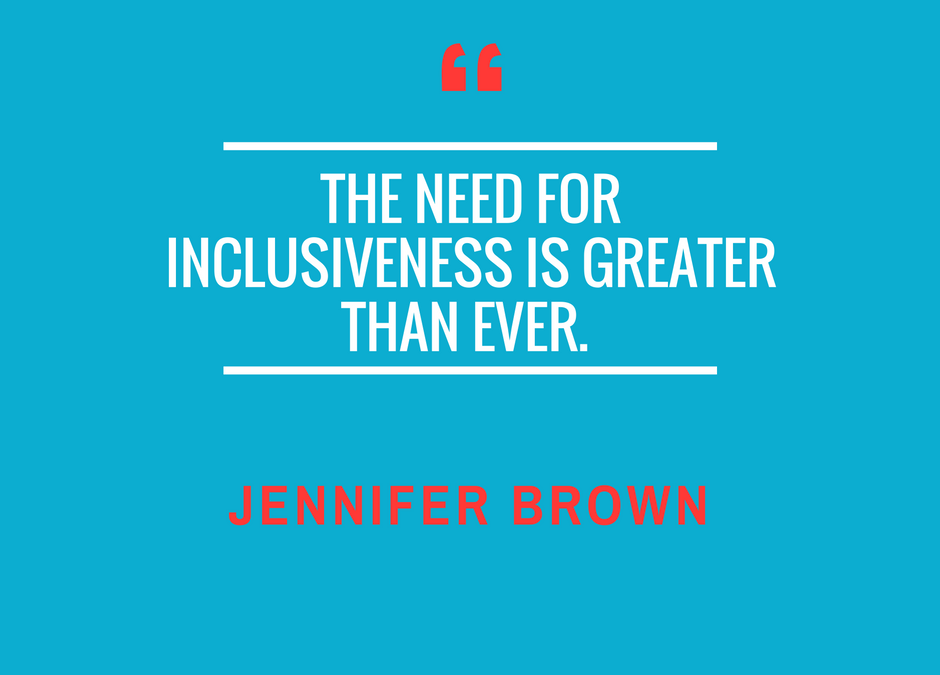As we all know (and have felt) by now, this year’s presidential campaign was incredibly divisive along the lines of gender, education, and ethnicity. The immediate spike in the number of hate crimes demonstrates how deep the fractures go in our society, and how exclusion – from economic opportunity, or by a hyper-focus on diversity – is being deeply felt and experienced by so many.
The inevitable, and uncomfortable, conclusion is that many of us were not aware of, or didn’t prioritize, full inclusion – in our lives, in our organizations, and in our society. Given this collective blind spot, and the new reality of our country’s incoming leadership as a result, what will we do differently as a community who continues to believe in the transformative power of valuing differences? The need for inclusiveness is greater than ever.
It comes down to who is involved. Some of us were already focused on reaching out, and beyond, to those on the margins of our efforts; in the LGBTQ community, this meant a focus on “straight allies” as champions willing to put their skin in the game on others’ behalf. Allyship is more keenly needed now, on behalf of multiple communities who feel unsafe or targeted, and it can be very simple to show solidarity.
But as someone who focuses on awakening change makers in organizations, I am reminded now more than ever of the opportunity to better engage our white, male colleagues in a different way. Heavily represented in leadership in most organizations, their involvement in building bridges – most importantly, to other men – is critical.
How do we invite them into dialogue about helping to ensure that all talent feel welcomed, valued, respected, and heard℠ in the workplace?
A couple of years ago, Chuck Shelton led an in-depth leadership survey entitled, The Study on White Men Leading through Diversity & Inclusion, and shared the following reflections on the findings:
- White men possess more than 40 percent of the leadership jobs in most companies, and that percentage increases dramatically by leadership level. The position, power, and leadership skills that white men possess need to align with the value that diversity and inclusion delivers.
- White male leaders are less engaged with diversity and inclusion (D&I) than their diverse colleagues. As such, they represent a significantly underperforming asset in every company’s global D&I investment portfolio.
- Progress is stifled by the perceived tension between the qualifications of diverse employees and the organizational commitment to diversity. Savvy leaders do not ignore or exaggerate dimensions of diversity; they lead with due regard for the way diversity operates in their relationships and sphere of influence. This is one way all leaders build trust.
Chuck surveyed 670 leaders, 58% of whom were white men, and asked them 94 diversity and inclusion-related questions.
Among his findings, Chuck observed:
“White men bring their own safety concerns to diversity discussions, and their diverse colleagues may wonder if white male inclusion will open doors for everyone. Almost 80% of all respondents rated white male managers highly on the ability to show respect for diverse co-workers. In contrast, only 36% of white male respondents rated white male leaders positively for saying just what needs to be said (candor) among diverse co-workers.”
Here’s what I see:
We’re asking white men to change what is a relatively more comfortable workplace culture for them, as well as to become voracious students of other cultures, experiences, and insights.
What they learn in becoming students of these cultures doesn’t always cast a flattering light on white men as a leader population. But they don’t share all of the burden; one survey respondent said, “I feel like we, as white men, are the forgotten group in the company, when it comes to diversity and inclusion.”
Exclusion is a powerful disincentive, and if white men imagine that they have been shut out of the inclusion conversation—and they do, even now—our current situation is instructive.
Every member of an underrepresented community has felt excluded many, many times; exclusion is more universal than we know.
Can white leaders harness the sense that they have been left behind long enough to begin to imagine what others have experienced routinely?
White men can learn to accept and invite difference; the rest of us need to find a way to include the dominant group without sublimating ourselves. The leaders who will successfully adjust will have to embrace discomfort and address their own possible misperception that they are under threat.
In short: They will have to become “comfortable with being uncomfortable.”
That, as I see it, is the only way forward… for all of us.
To learn more about engaging all levels of leadership in organizational change efforts around diversity and inclusion, pick up a copy of my book, Inclusion: Diversity, the New Workplace, and the Will to Change, released this month, and visit us at www.jenniferbrownspeaks.com
Author: Jennifer Brown is an award-winning entrepreneur, dynamic speaker and diversity and inclusion expert. Informed by more than a decade consulting to Fortune 500 companies, her new book entitled Inclusion: Diversity, the New Workplace & the Will to Change (Advantage Media Group, November 2016) creates a compelling case for leadership to embrace the opportunity that diversity represents, for their own growth and for the success of their organizations, while simultaneously empowering advocates at all levels to find their voice and be a driving force in creating more enlightened organizations that resonate in a fast-changing world.


Recent Comments